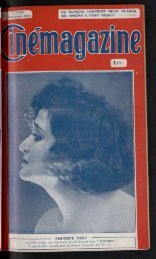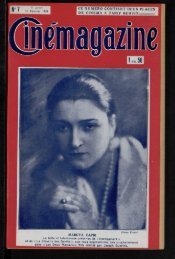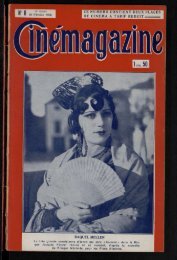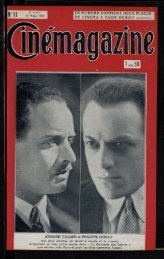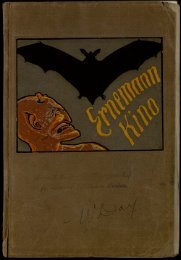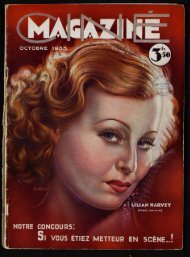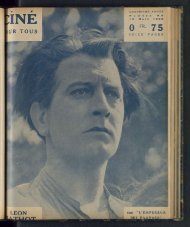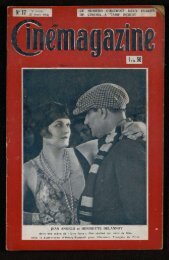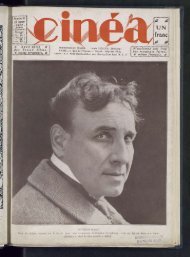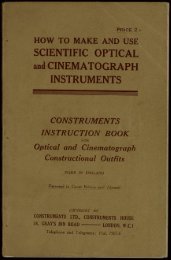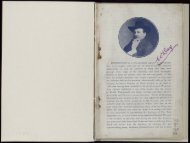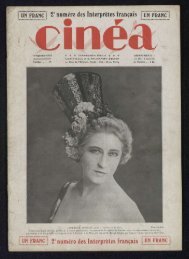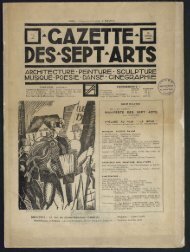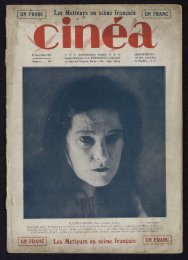Untitled
Untitled
Untitled
You also want an ePaper? Increase the reach of your titles
YUMPU automatically turns print PDFs into web optimized ePapers that Google loves.
62 MODERN MAGIC LANTERNS.<br />
planted by the form shown in B, in which two lenses are<br />
employed, both with one convex and one plain surface, the<br />
convex sides facing one another, and almost in contact. This<br />
is an excellent form of condenser for all ordinary purposes,<br />
if well made, and is met with far more often than any other<br />
pattern. At c is another very good condenser known as<br />
Herschel's, which is also often fitted to lanterns, and answers<br />
in practice as well as B ; it is often made with the meniscus<br />
or concavo-convex lens a little smaller than the other, and the<br />
double convex lens has its inner curve flattened, in which form<br />
it is known as Gravett's. n is one of the forms suggested<br />
for a triple condenser, or one made of three lenses ; we lately<br />
saw a lantern fitted with a triple condenser with a very<br />
satisfactory result.<br />
It will be seen from Fig. 52 that the amount of light<br />
which falls upon a condenser, and which may be roughly<br />
considered as the<br />
amount available for<br />
illuminating the slide,<br />
depends upon the<br />
diameter of the condenser<br />
and the distance<br />
at which it must be<br />
from the lamp, for it<br />
is obvious that a condenser<br />
at A would receive<br />
more light than<br />
Fig. 52. one of the same size at<br />
DIAGRAM TO SHOW THAT THE NEARER THE<br />
CONDENSER IS TO THE SOURCE OF LIGHT,<br />
THE MORE LIGHT IT RECEIVES.<br />
B, since in the first case<br />
not only will the rays<br />
EE F F fall upon it which<br />
fell upon B, but it will embrace G G H H. Certain practical<br />
considerations, particularly the danger of having the thick<br />
glass of a lens too near the light and consequent heat,<br />
prevent the general use of condensers of such a size and<br />
focus as to make the angle at c more than about 70 degrees.<br />
For the usual photographic slide with a circular mask a<br />
condenser of 4 inches diameter will be found large enough,<br />
but if slides with very large masks with square corners are<br />
to be shown, such a size will not be found sufficient, and<br />
THE OPTICAL SYSTEM.<br />
a 41 inch will be wanted. In getting a condenser, two<br />
points should have attention : the glasses should be mounted<br />
quite loosely in their brass rings so as to rattle when shaken,<br />
if not, when expanded with the heat of the lamp they will<br />
most likely break, and the lenses<br />
63<br />
themselves should be as<br />
thin as possible at their edges. The slide should be as near<br />
to the condenser as the carrier will allow. For photographic<br />
enlarging, condensers will be required of a size dependent<br />
upon that of the negative from which the enlargement is to<br />
be made ; for good illumination its diameter should be at least<br />
an inch longer than the diagonal of the negative.<br />
The objective for projection purposes is, in the cheapest<br />
lanterns, what is called a piano-convex (A, Fig. 53), or a<br />
meniscus (B and c), but these are not at all to be desired,<br />
Fig. 53. LANTERN OBJ...CTIVES.<br />
especially in those of short focus ; foranything over 10 inches<br />
they are frequently very satisfactory. With the introduction<br />
of the rapid modern dry-plate in photography, however, the<br />
necessity for the very " quick " lenses for portraiture has<br />
largely disappeared, and portrait lenses as used by photographers<br />
answer all the requirements of the average lanternist<br />
admirably, and are frequently to be met with at a very low<br />
price. This lens, shown diagrammatically in Fig. 53, D, was<br />
the invention of Professor Petzval; and it or its modifications<br />
in the hands of Dallmeyer are excellent for projection. Several<br />
opticians now make special lantern lenses, based more or less<br />
upon this pattern, one or two of which we have used at one<br />
time or another with satisfaction. This type not only allows<br />
a large amount of light to pass, but it also possesses a very<br />
flat field, a quality the nature of which must be explained.



